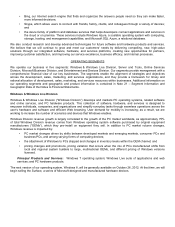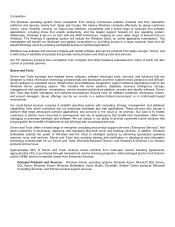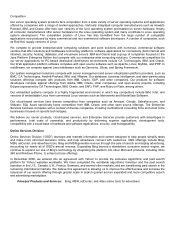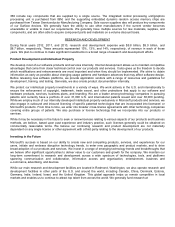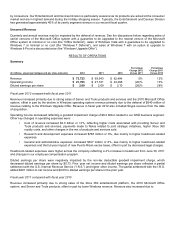Microsoft 2012 Annual Report Download - page 19
Download and view the complete annual report
Please find page 19 of the 2012 Microsoft annual report below. You can navigate through the pages in the report by either clicking on the pages listed below, or by using the keyword search tool below to find specific information within the annual report.devices, our goal is to provide users with a consistent and compelling experience through a common user interface and
our services such as SkyDrive, Xbox LIVE, Bing, Skype, and our Windows Azure cloud platform.
Communications and productivity
The ubiquity of computing and software tools has transformed personal and business productivity. Over the last decade,
Microsoft redefined software productivity beyond the rich Office client on the PC. Productivity scenarios now encompass
unified communications such as instant messaging, voice, and video communications, business intelligence,
collaboration, content management, and relationship management, all of which are increasingly available through server-
side applications. These server applications can be hosted in the cloud by the customer, a partner, or by Microsoft. There
are significant opportunities to bring to life productivity and communication scenarios across PCs, mobile, and other
devices that connect to services. We invest significant resources in our products and services that make this possible –
Dynamics, Exchange, Lync, Skype, Office, Office 365, SharePoint, Windows Live, and Windows Phone.
Cloud computing transforming the data center and information technology
Cloud-based solutions provide customers with software, services, and content over the Internet by way of shared
computing resources located in centralized data centers. Computing is undergoing a long-term shift from client/server to
the cloud, a shift similar in importance and impact to the transition from mainframe to client/server. The shift to the cloud is
driven by three important economies of scale: larger data centers can deploy computational resources at significantly
lower cost per unit than smaller ones; larger data centers can coordinate and aggregate diverse customer, geographic,
and application demand patterns improving the utilization of computing, storage, and network resources; and multi-
tenancy lowers application maintenance labor costs for large public clouds. Because of the improved economics, the
cloud offers unique levels of elasticity and agility that enables new solutions and applications. For businesses of all sizes,
the cloud creates the opportunity to focus on innovation while leaving non-differentiating activities to reliable and cost-
effective providers. We are devoting significant resources to developing cloud infrastructure, platforms, and applications
including offerings such as Microsoft Dynamics Online, Microsoft SQL Azure, Office 365, Windows Azure, Windows
Intune, and Windows Server.
Economic Conditions, Challenges, and Risks
As discussed above, our industry is dynamic and highly competitive. We must anticipate changes in technology and
business models. Our model for growth is based on our ability to initiate and embrace disruptive technology trends, to
enter new markets, both in terms of geographies and product areas, and to drive broad adoption of the products and
services we develop and market.
At Microsoft, we prioritize our investments among the highest long-term growth opportunities. These investments require
significant resources and are multi-year in nature. The products and services we bring to market may be developed
internally, brought to market as part of a partnership or alliance, or through acquisition.
Our success is highly dependent on our ability to attract and retain qualified employees. We hire a mix of university and
industry talent worldwide. Microsoft competes for talented individuals worldwide by offering broad customer reach, scale
in resources, and competitive compensation.
Demand for our software, services, and hardware has a strong correlation to global macroeconomic factors. The current
macroeconomic factors remain dynamic. See a discussion of these factors and other risks under Risk Factors in our fiscal
year 2012 Form 10-K.
Seasonality
Our revenue historically has fluctuated quarterly and has generally been the highest in the second quarter of our fiscal
year due to corporate calendar year-end spending trends in our major markets and holiday season spending


